Home /
Expert Answers /
Economics /
6-using-a-payoff-matrix-to-determine-the-equilibrium-outcome-suppose-that-snapface-and-instashot-a-pa223
(Solved): 6. Using a payoff matrix to determine the equilibrium outcome Suppose that Snapface and Instashot a ...

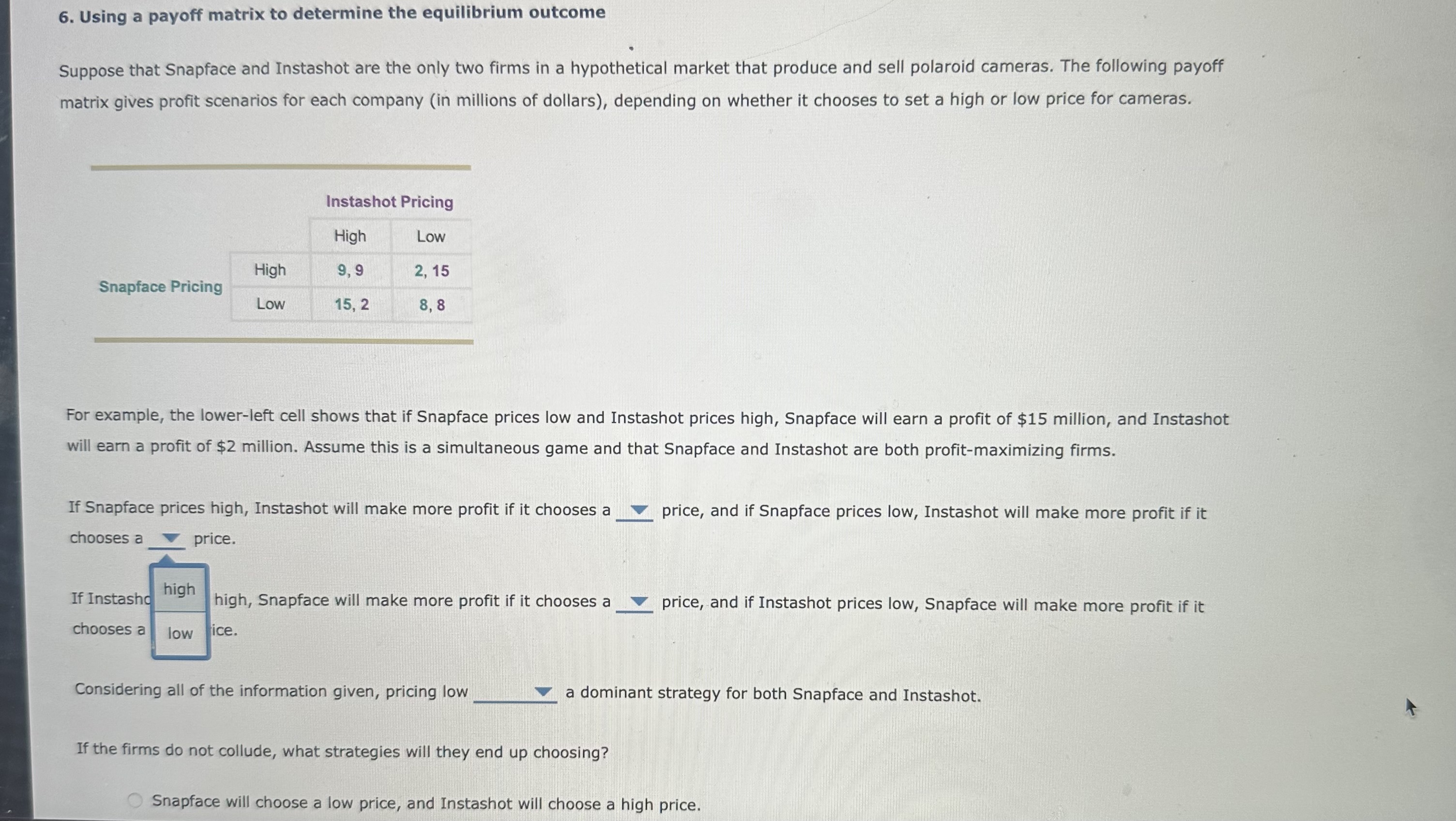
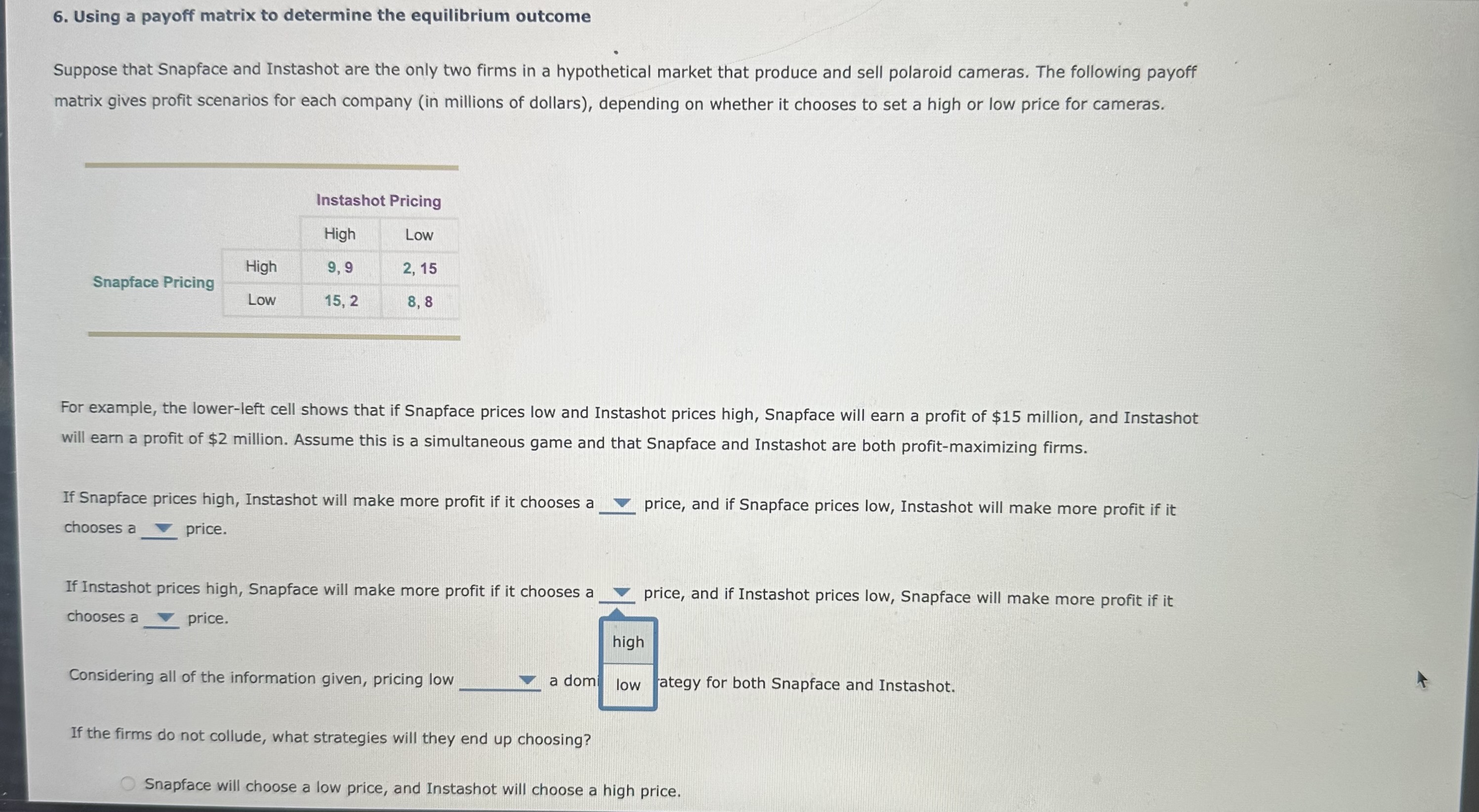
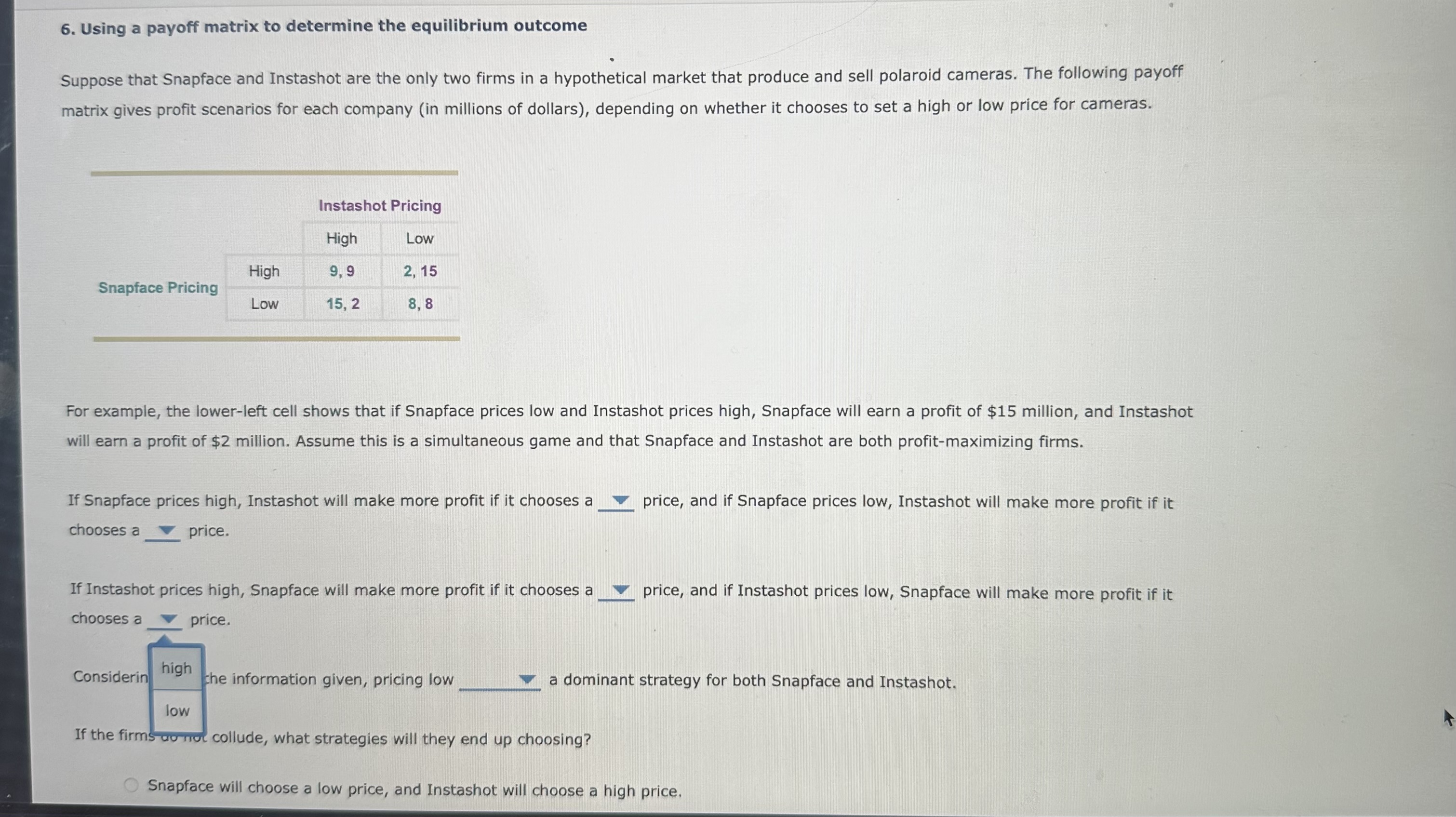
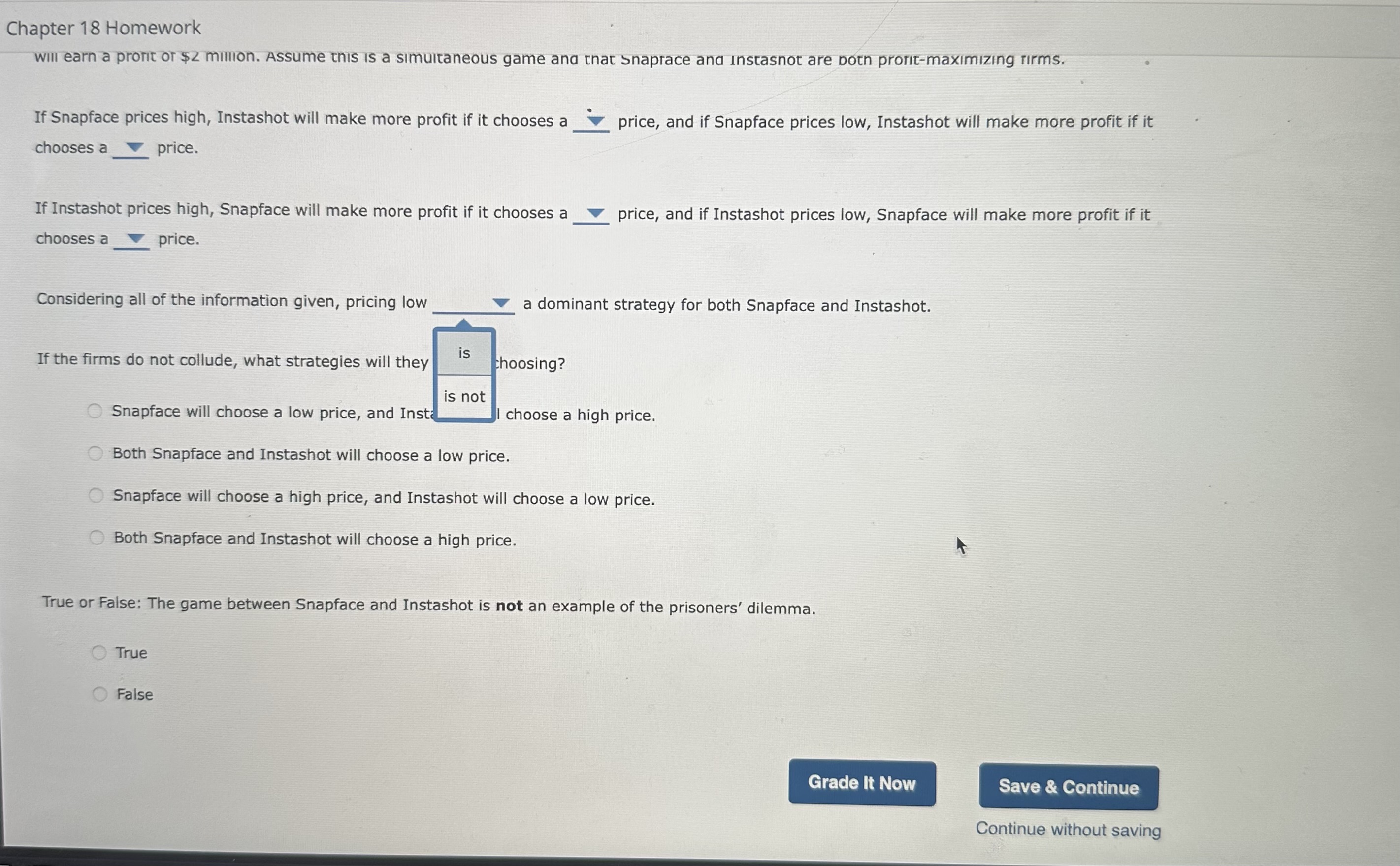
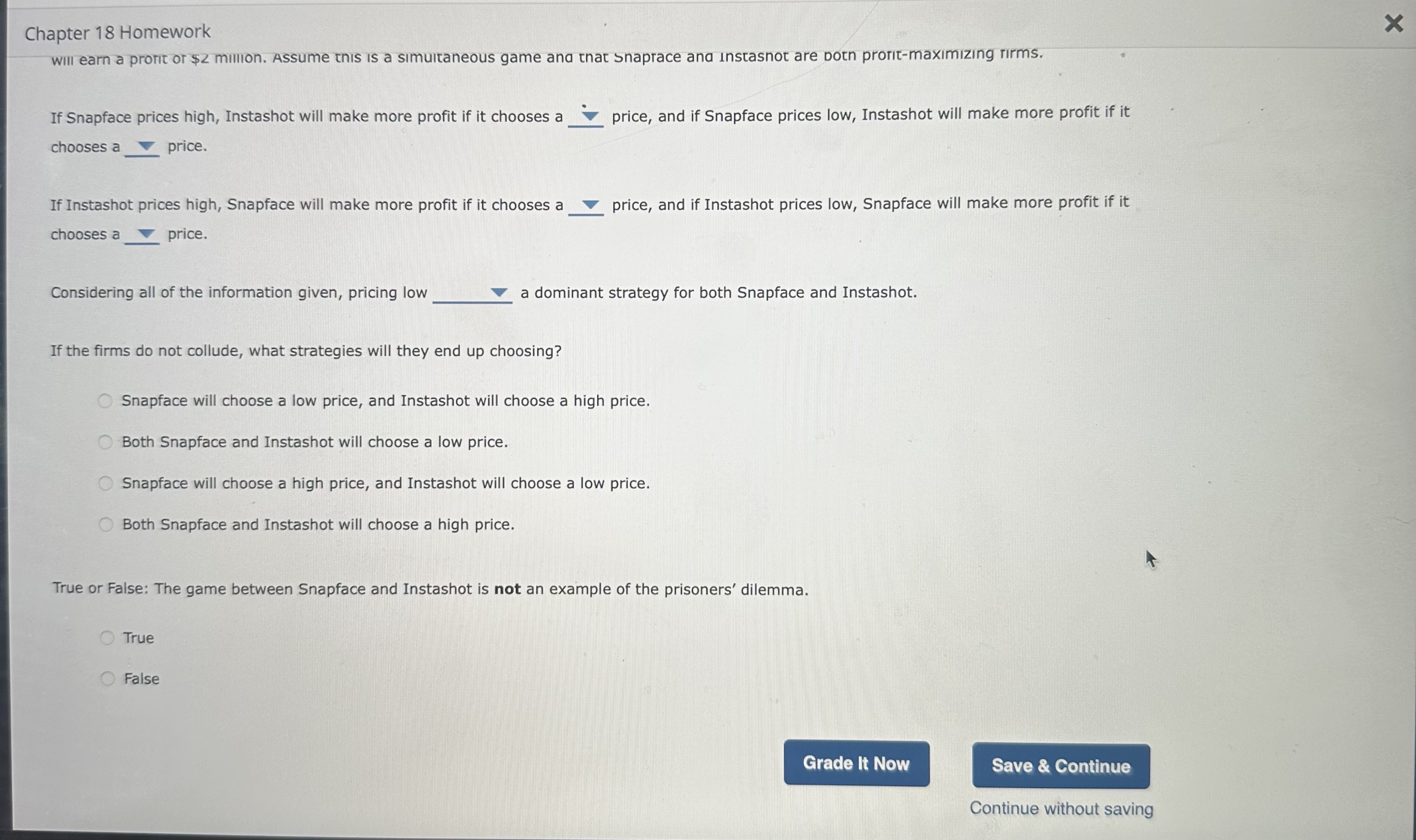
6. Using a payoff matrix to determine the equilibrium outcome Suppose that Snapface and Instashot are the only two firms in a hypothetical market that produce and sell polaroid cameras. The following payoff matrix gives profit scenarios for each company (in millions of dollars), depending on whether it chooses to set a high or low price for cameras. For example, the lower-left cell shows that if Snapface prices low and Instashot prices high, Snapface will earn a profit of million, and Instashot will earn a profit of million. Assume this is a simultaneous game and that Snapface and Instashot are both profit-maximizing firms. If Snapface prices high, Instashot will make more profit if it chooses a price, and if Snapface prices low, Instashot will make more profit if it chooses a price. If Instashot prices high, Snapface will make more profit if it chooses a ce, and if Instashot prices low, Snapface will make more profit if it chooses a price. Considering all of the information given, pricing low a dominant strategy for both Snapface and Instashot. If the firms do not collude, what strategies will they end up choosing? Snapface will choose a low price, and Instashot will choose a high price.
6. Using a payoff matrix to determine the equilibrium outcome Suppose that Snapface and Instashot are the only two firms in a hypothetical market that produce and sell polaroid cameras. The following payoff matrix gives profit scenarios for each company (in millions of dollars), depending on whether it chooses to set a high or low price for cameras. For example, the lower-left cell shows that if Snapface prices low and Instashot prices high, Snapface will earn a profit of million, and Instashot will earn a profit of million. Assume this is a simultaneous game and that Snapface and Instashot are both profit-maximizing firms. If Snapface prices high, Instashot will make more profit if it chooses a price, and if Snapface prices low, Instashot will make more profit if it chooses a price. If Instash high, Snapface will make more profit if it chooses a price, and if Instashot prices low, Snapface will make more profit if it chooses ce. Considering all of the information given, pricing low a dominant strategy for both Snapface and Instashot. If the firms do not collude, what strategies will they end up choosing? Snapface will choose a low price, and Instashot will choose a high price.
6. Using a payoff matrix to determine the equilibrium outcome Suppose that Snapface and Instashot are the only two firms in a hypothetical market that produce and sell polaroid cameras. The following payoff matrix gives profit scenarios for each company (in millions of dollars), depending on whether it chooses to set a high or low price for cameras. For example, the lower-left cell shows that if Snapface prices low and Instashot prices high, Snapface will earn a profit of million, and Instashot will earn a profit of million. Assume this is a simultaneous game and that Snapface and Instashot are both profit-maximizing firms. If Snapface prices high, Instashot will make more profit if it chooses a price, and if Snapface prices low, Instashot will make more profit if it chooses a price. If Instashot prices high, Snapface will make more profit if it chooses a price, and if Instashot prices low, Snapface will make more profit if it chooses a price. Considering all of the information given, pricing low a don ategy for both Snapface and Instashot. If the firms do not collude, what strategies will they end up choosing? Snapface will choose a low price, and Instashot will choose a high price.
6. Using a payoff matrix to determine the equilibrium outcome Suppose that Snapface and Instashot are the only two firms in a hypothetical market that produce and sell polaroid cameras. The following payoff matrix gives profit scenarios for each company (in millions of dollars), depending on whether it chooses to set a high or low price for cameras. For example, the lower-left cell shows that if Snapface prices low and Instashot prices high, Snapface will earn a profit of million, and Instashot will earn a profit of million. Assume this is a simultaneous game and that Snapface and Instashot are both profit-maximizing firms. If Snapface prices high, Instashot will make more profit if it chooses a price, and if Snapface prices low, Instashot will make more profit if it chooses a price. If Instashot prices high, Snapface will make more profit if it chooses a price, and if Instashot prices low, Snapface will make more profit if it chooses a price. Considerir he information given, pricing low a dominant strategy for both Snapface and Instashot. If the firmis cor mo collude, what strategies will they end up choosing? Snapface will choose a low price, and Instashot will choose a high price.
Will earn a prorit or \$2 milion. Assume this is a simultaneous game ana that snaprace ana instasnot are Dotn prorit-maximizing rirms. If Snapface prices high, Instashot will make more profit if it chooses a price, and if Snapface prices low, Instashot will make more profit if it chooses a price. If Instashot prices high, Snapface will make more profit if it chooses a price, and if Instashot prices low, Snapface will make more profit if it chooses a price. Considering all of the information given, pricing low a dominant strategy for both Snapface and Instashot. If the firms do not collude, what strategies will they :hoosing? Snapface will choose a low price, and Inst I choose a high price. Both Snapface and Instashot will choose a low price. Snapface will choose a high price, and Instashot will choose a low price. Both Snapface and Instashot will choose a high price. True or False: The game between Snapface and Instashot is not an example of the prisoners' dilemma. True False Continue without saving
Chapter 18 Homework will earn a prorit or million. Assume this is a sımultaneous game ana that snaprace ana instasnot are potn prorit-maximizing rirms. If Snapface prices high, Instashot will make more profit if it chooses a price, and if Snapface prices low, Instashot will make more profit if it chooses a price. If Instashot prices high, Snapface will make more profit if it chooses a price, and if Instashot prices low, Snapface will make more profit if it chooses a price. Considering all of the information given, pricing low a dominant strategy for both Snapface and Instashot. If the firms do not collude, what strategies will they end up choosing? Snapface will choose a low price, and Instashot will choose a high price. Both Snapface and Instashot will choose a low price. Snapface will choose a high price, and Instashot will choose a low price. Both Snapface and Instashot will choose a high price. True or False: The game between Snapface and Instashot is not an example of the prisoners' dilemma. True False